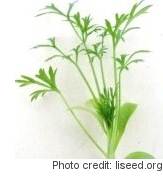Growing Cilantro Microgreens Indoors

Growing cilantro microgreens indoors is a great way to ensure a constant supply of fresh, organic herbs at home. Cilantro microgreens, if you don't know, refer to the edible cilantro greens harvested at their early seedling stage. They boast a vibrant parsley flavor with hints of citrus and can be used as a flavor element in dishes, or as a garnish in lieu of parsley. Cilantro microgreens can be grown in containers, indoors or out, at any time of year including in winter. They will be ready to harvest and eat within 3 to 4 weeks from sowing.
- First, buy organic cilantro/coriander seeds from a reputable supplier. Note that cilantro/coriander seeds may be sold by the alternative names of this culinary herb such as Chinese parsley or dhania. Scientifically, cilantro is known as Coriandrum sativum.
- Prior to planting, soak cilantro seeds in a glass bowl filled with clean water. Soaking cilantro seeds overnight will speed up the germination process.
- Fill a shallow container or pot with sterilized seed-starting mix and moisten the mix with a spray bottle. Sprinkle cilantro seeds over the potting soil, being careful to spread them as evenly as possible. After sowing, cover the tiny cilantro seeds with a moist paper towel. The paper towel should be removed once the microgreens push it up with their growth.
- Place the container in a sunny spot. If you want to grow cilantro micro-greens indoors, a south-facing window is usually a good location.
- Keep the soil moist, but not saturated with water. If you over-water your emerging cilantro microgreens, you may ruin your whole crop as these young seedlings are very vulnerable to over-watering. To keep your cilantro microgreen garden nourished, use a spray bottle to gently mist the soil. Once the seedlings are well established, you can also use your kitchen sink spray nozzle or a small watering can.
- Due to their tough seed coats, cilantro seeds are fairly slow to germinate compared to other microherbs. After 2 to 3 weeks from sowing your cilantro microgreens should've reached about 2 inches in height and developed the first set of true leaves — this is when you want to harvest them. (Note that the very first leaves that you see after germination are cotyledon leaves which don't look like real cilantro leaves. The next set of micro-sized leaves resemble real cilantro leaves and are called true leaves.) After harvesting, serve and eat your cilantro microgreens immediately. With their a vibrant flavor and attractive leaves, cilantro microgreens can be used as a flavor element in a wide variety of dishes or as a garnish in lieu of parsley.
- Once you've used up your crop, start a new cilantro crop, or try growing other herbs and vegetables as microgreens. Good options include sunflower shoots, snow pea shoots, baby Swiss chard, micro parsley, and celery microgreens.

